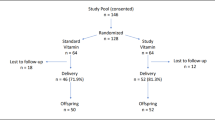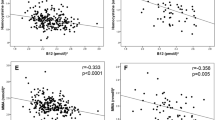Abstract
Background/Objectives:
Vitamin B12 (B12) deficiency is common in Indians and a major contributor to hyperhomocysteinemia, which may influence fetal growth, risk of type II diabetes and cardiovascular disease. The purpose of this paper was to study the effect of physiological doses of B12 and folic acid on plasma total homocysteine (tHcy) concentration.
Subjects/Methods:
A cluster randomized, placebo-controlled, double-blind, 2 × 3 factorial trial, using the family as the randomization unit. B12 was given as 2 or 10 μg capsules, with or without 200 μg folic acid, forming six groups (B0F0, B2F0, B10F0, B0F200, B2F200 and B10F200). Plasma tHcy concentration was measured before and after 4 and 12 months of supplementation.
Results:
From 119 families in the Pune Maternal Nutrition Study, 300 individuals were randomized. There was no interaction between B12 and folic acid (P=0.14) in relation to tHcy concentration change and their effects were analyzed separately: B0 vs. B2 vs. B10; and F0 vs. F200. At 12 months, tHcy concentration reduced by a mean 5.9 (95% CI: −7.8, −4.1) μmol/l in B2, and by 7.1 (95% CI: −8.9, −5.4) μmol/l in B10, compared to nonsignificant rise of 1.2 (95% CI: −0.5, 2.9) μmol/l in B0. B2 and B10 did not differ significantly. In F200, tHcy concentration decreased by 4.8 (95% CI: −6.3, −3.3) μmol/l compared to 2.8 (95% CI: −4.3, −1.2) μmol/l in F0.
Conclusion:
Daily oral supplementation with physiological doses of B12 is an effective community intervention to reduce tHcy. Folic acid (200 μg per day) showed no additional benefit, neither had any unfavorable effects.
This is a preview of subscription content, access via your institution
Access options
Subscribe to this journal
Receive 12 print issues and online access
$259.00 per year
only $21.58 per issue
Buy this article
- Purchase on Springer Link
- Instant access to full article PDF
Prices may be subject to local taxes which are calculated during checkout



Similar content being viewed by others
References
Bhat DS, Thuse NV, Lubree HG, Joglekar CV, Naik SS, Ramdas LV et al. (2009). Increases in plasma holotranscobalamin can be used to assess vitamin B-12 absorption in individuals with low plasma vitamin B-12. J Nutr 139, 2119–2123.
Bhate V, Deshpande S, Bhat D, Joshi N, Ladkat R, Watve S et al. (2008). Vitamin B12 status of pregnant Indian women and cognitive function in their 9-year-old children. Food Nutr Bull 29, 249–254.
Blacher J, Czernichow S, Raphael M, Roussel C, Chadefaux-Vekemans B, Morineau G et al. (2007). Very low oral doses of vitamin B-12 increase serum concentrations in elderly subjects with food-bound vitamin B-12 malabsorption. J Nutr 137, 373–378.
Bor MV, Lydeking-Olsen E, Moller J, Nexo E (2006). A daily intake of approximately 6 microg vitamin B-12 appears to saturate all the vitamin B-12-related variables in Danish postmenopausal women. Am J Clin Nutr 83, 52–58.
Carmel R (2008). Efficacy and safety of fortification and supplementation with vitamin B12: biochemical and physiological effects. Food Nutr Bull 29, S177–S187.
Chambers JC, Obeid OA, Refsum H, Ueland P, Hackett D, Hooper J et al. (2000). Plasma homocysteine concentrations and risk of coronary heart disease in UK Indian Asian and European men. Lancet 355, 523–527.
Chandalia M, Abate N, Cabo-Chan AVJ, Devaraj S, Jialal I, Grundy SM (2003). Hyperhomocysteinemia in Asian Indians living in the United States. J Clin Endocrinol Metab 88, 1089–1095.
Clarke R, Grimley EJ, Schneede J, Nexo E, Bates C, Fletcher A et al. (2004). Vitamin B12 and folate deficiency in later life. Age Ageing 33, 34–41.
Dhonukshe-Rutten RA, van ZM, de Groot LC, Eussen SJ, Blom HJ, van Staveren WA (2005). Effect of supplementation with cobalamin carried either by a milk product or a capsule in mildly cobalamin-deficient elderly Dutch persons. Am J Clin Nutr 82, 568–574.
Elshorbagy AK, Valdivia-Garcia M, Refsum H, Smith AD, Mattocks DA, Perrone CE et al. (2009). Sulfur amino acids in methionine-restricted rats: hyperhomocysteinemia. Nutrition doi: 10.1016/j.nut.2009.09.017.
Eussen SJ, de Groot LC, Clarke R, Schneede J, Ueland PM, Hoefnagels WH et al. (2005). Oral cyanocobalamin supplementation in older people with vitamin B12 deficiency: a dose-finding trial. Arch Intern Med 165, 1167–1172.
Horne DW, Patterson D (1988). Lactobacillus casei microbiological assay of folic acid derivatives in 96-well microtiter plates. Clin Chem 34, 2357–2359.
Hustad S, Ueland PM, Vollset SE, Zhang Y, Bjørke-Monsen AL, Schneede J (2000). Riboflavin as a determinant of plasma total homocysteine: effect modification by the methylenetetrahydrofolate reductase C677T polymorphism. Clin Chem 46, 1065–1071.
Ingenbleek Y, Hardillier E, Jung L (2002). Subclinical protein malnutrition is a determinant of hyperhomocysteinemia. Nutrition 18, 40–46.
Kelleher BP, Walshe KG, Scott JM, O'Broin SD (1987). Microbiological assay for vitamin B12 with use of a colistin-sulfate-resistant organism. Clin Chem 33, 52–54.
Kelleher BP, Broin SD (1991). Microbiological assay for vitamin B12 performed in 96-well microtitre plates. J Clin Pathol 44, 592–595.
Rao S, Yajnik CS, Kanade A, Fall CH, Margetts BM, Jackson AA et al. (2001). Intake of micronutrient-rich foods in rural Indian mothers is associated with the size of their babies at birth: Pune Maternal Nutrition Study. J Nutr 131, 1217–1224.
Refsum H, Yajnik CS, Gadkari M, Schneede J, Vollset SE, Orning L et al. (2001). Hyperhomocysteinemia and elevated methylmalonic acid indicate a high prevalence of cobalamin deficiency in Asian Indians. Am J Clin Nutr 74, 233–241.
Refsum H, Smith AD, Ueland PM, Nexo E, Clarke R, McPartlin J et al. (2004). Facts and recommendations about total homocysteine determinations: an expert opinion. Clin Chem 50, 3–32.
Rose G (1985). Sick individuals and sick populations. Int J Epidemiol 14, 32–38.
Selhub J (1999). Homocysteine metabolism. Annu Rev Nutr 19, 217–246.
Selhub J (2008). Public health significance of elevated homocysteine. Food Nutr Bull 29, S116–S125.
Shipchandler M, Moore E (1995). Rapid, fully automated measurement of plasma homocyst(e)ine with the Abbott IMx analyzer. Clin Chem 41, 991–994.
Smith AD (2008). The worldwide challenge of the dementias: a role for B vitamins and homocysteine? Food Nutr Bull 29, S143–S172.
Tamura T, Freeberg L, Cornwell P (1990). Inhibition of EDTA of growth of Lactobacillus casei in the folate microbiological assay and its reversal by added manganese or iron. Clin Chem 36, 1993.
The Flour Fortification Initiative website (2009). Meeting on flour fortification in India. http://www.sph.emory.edu/wheatflour/IndiaMeeting/ (accessed 19th March 2009).
Tucker KL, Olson B, Bakun P, Dallal GE, Selhub J, Rosenberg IH (2004). Breakfast cereal fortified with folic acid, vitamin B-6, and vitamin B-12 increases vitamin concentrations and reduces homocysteine concentrations: a randomized trial. Am J Clin Nutr 79, 805–811.
van VT, Jacobs RG, de DE, van den Berg H, de BA, van der Put NM (2007). Effect of fortified spread on homocysteine concentration in apparently healthy volunteers. Eur J Clin Nutr 61, 769–778.
Vollset SE, Refsum H, Irgens LM, Emblem BM, Tverdal A, Gjessing HK et al. (2000). Plasma total homocysteine, pregnancy complications, and adverse pregnancy outcomes: the hordaland homocysteine study. Am J Clin Nutr 71, 962–968.
Wald DS, Law M, Morris JK (2002). Homocysteine and cardiovascular disease: evidence on causality from a meta-analysis. BMJ 325, 1202.
Winkels RM, Brouwer IA, Clarke R, Katan MB, Verhoef P (2008). Bread cofortified with folic acid and vitamin B-12 improves the folate and vitamin B-12 status of healthy older people: a randomized controlled trial. Am J Clin Nutr 88, 348–355.
Yajnik CS, Deshpande SS, Panchanadikar AV, Naik SS, Deshpande JA, Coyaji KJ et al. (2005). Maternal total homocysteine concentration and neonatal size in India. Asia Pac J Clin Nutr 14, 179–181.
Yajnik CS, Deshpande SS, Lubree HG, Naik SS, Bhat DS, Uradey BS et al. (2006). Vitamin B12 deficiency and hyperhomocysteinemia in rural and urban Indians. J Assoc Physicians India 54, 775–782.
Yajnik CS, Lubree HG, Thuse NV, Ramdas LV, Deshpande SS, Deshpande VU et al. (2007). Oral vitamin B12 supplementation reduces plasma total homocysteine concentration in women in India. Asia Pac J Clin Nutr 16, 103–109.
Yajnik CS, Deshpande SS, Jackson AA, Refsum H, Rao S, Fisher DJ et al. (2008). Vitamin B12 and folate concentrations during pregnancy and insulin resistance in the offspring: the Pune Maternal Nutrition Study. Diabetologia 51, 29–38.
Acknowledgements
We are grateful to the community, in particular the children and their families from the PMNS, for taking part in this study and to NuLife Pharmaceuticals Ltd, India for free supply of the study medicine. We thank Dr K J Coyaji, Director, KEM Hospital for providing facilities. We are grateful to Pallavi C Yajnik, the staff at Diabetes Unit and the paramedical field workers for practical assistance during the trial, to Professor Elaine Rush for her comments and to Carole Johnston for help in laboratory analysis. The study was supported by funds from the Wellcome Trust, London, UK.
Author information
Authors and Affiliations
Corresponding author
Ethics declarations
Competing interests
The authors declare no conflict of interest.
Additional information
Contributors: CSY, CHF, HR, ASN and AAJ planned the study. USD supervised the study operations that were contributed by HGL, LVR, DSB, SSN, PSH, DAR and TBK; CVJ and AKW performed the statistical analysis; USD, CSY, ASN, CHF and HR wrote the paper.
Supplementary Information accompanies the paper on European Journal of Clinical Nutrition website
Supplementary information
Rights and permissions
About this article
Cite this article
Deshmukh, U., Joglekar, C., Lubree, H. et al. Effect of physiological doses of oral vitamin B12 on plasma homocysteine: a randomized, placebo-controlled, double-blind trial in India. Eur J Clin Nutr 64, 495–502 (2010). https://doi.org/10.1038/ejcn.2010.15
Received:
Revised:
Accepted:
Published:
Issue Date:
DOI: https://doi.org/10.1038/ejcn.2010.15
Keywords
This article is cited by
-
Effect of 8-week oral supplementation with 3-µg cyano-B12 or hydroxo-B12 in a vitamin B12-deficient population
European Journal of Nutrition (2019)
-
The Pune Rural Intervention in Young Adolescents (PRIYA) study: design and methods of a randomised controlled trial
BMC Nutrition (2017)
-
Daily milk intake improves vitamin B-12 status in young vegetarian Indians: an intervention trial
Nutrition Journal (2013)
-
Oral vitamin B12 for patients suspected of subtle cobalamin deficiency: a multicentre pragmatic randomised controlled trial
BMC Family Practice (2011)
-
Vitamin intervention
Nature India (2010)



